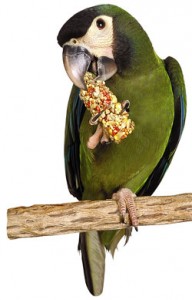 Food plays an essential role in the survival of every living creature. It can also be a source of great pleasure. Animal trainers, behaviorists, pet owners, and, yes, parents of young children, use food in a number of creative ways. Most people love giving their animals friends food treats. How can a concerned bird lover determine what foods are acceptable for their parrots, as well as understand how to use some of those foods as treats and as toys?
Food plays an essential role in the survival of every living creature. It can also be a source of great pleasure. Animal trainers, behaviorists, pet owners, and, yes, parents of young children, use food in a number of creative ways. Most people love giving their animals friends food treats. How can a concerned bird lover determine what foods are acceptable for their parrots, as well as understand how to use some of those foods as treats and as toys?
A balanced and nutritious daily diet is of primary importance. First, it is essential that your pet bird eats a healthy diet daily. Also, your bird’s diet must provide a certain amount of psychological and emotional satisfaction. Your avian veterinarian can be an excellent source of information about the best diet for your particular avian friend. Unlike many years ago, when little was known about birds’ nutritional needs, many resources now exist for the practitioner who wishes to study avian nutrition. Your local veterinarian will also know what foods are more accessible in your geographic area.
Another reliable source for basic diet information is a bird breeder who has a long history in the industry and an excellent reputation for keeping healthy breeding birds and babies. Find someone, if possible, who specializes in your kind of bird. Some species appear to have slightly different dietary requirements. Find out if your bird is one of those with more specialized needs. This is a relatively new consideration, and there are still only a few hard statistics pertaining to it in scientific literature.
Reputable pet bird breeders and veterinarians do their best to keep up to date and inform their clients of new data as it becomes available. Books are available that discuss good husbandry practices and suggest diets for the avian companion. There are organizations and bird clubs, some of which focus on one particular avian species. They are often good sources for up-to-date dietary information.
Once your pet bird is eating a balanced and appropriate diet, what about toy or treat foods? When are those types of foods appropriate, and which ones make the best toys or treats? Why are they important for many birds, and how can we best use them?
Easily Destroyed Foods Are Fun
In the wild, parrots spend many hours foraging. Once hunger has been satisfied, time is spent shredding leaves, twigs, and food matter, in the process scattering seeds for future food growth. Birds that have a strong need for this kind of activity can benefit greatly when provided with similar activities in a domestic environment. Some pet parrots that are not given enough material to shred and destroy begin to pick at anything that satisfies that particular need or sensation. Unfortunately, those items usually consist of things that people do not want to have damaged. They forget that nothing is sacred to a bird on a seek-and-destroy mission.
Throughout the years, clients have related numerous horror stories of their destructive birds, describing damage that runs from the annihilation of treasured antique furniture to near disastrous encounters with electrical cords.
Many years ago, one of my clients was a dealer in very old and very expensive antiques. Unfortunately, she learned the hard way, exactly why it is not wise to place a cockatoo‘s cage in front of a one-of-a-kind, 500-year-old hanging tapestry. Some easily shredded toys or foods might have directed the bird’s attention to a less expensive object. The wisest option, of course, would have been to move the tapestry as fare away from the bird as was possible.
Leaving the worst case scenario for last, some companion parrots (when denied shredding activity) resort to destroying their own feathers or, in the very worst cases, their own flesh!
The Best Foods for Your Pet Bird
Before using food as a treat or as a toy, assess your parrot’s needs, interests, and general behavior. For example, does your bird eat things that are not edible? Those little “Billy goat birds” require careful supervision. Everything given to them must be either edible or indestructible, and they will not do well with objects that are meant to be shredded but not eaten.
Most pet birds seem to take great delight in ingesting food that have a variety of tastes, colors and textures. Because their lives in the wild are so active, colorful and exciting, food can be a wonderful, easily provided and inexpensive source of interest for the domestically raised companion bird.
Study your parrot’s reaction to various foods. Although there is little or no hard scientific data supporting the hard scientific data supporting the alteration of birds’ moods or behaviors after eating certain foods, I have often found that some birds seem to consistently behavior more aggressively or irritably on particular foods.
For example, some birds react strongly to eating sunflower seeds. Although many people scoff at this, I can attest that numerous clients found that their birds had a similar sensitivity to them. We determined this by keeping a behavior diary. When I first began working behaviorally with birds 25 years ago, there were few dietary options available to bird owners. At the time, sunflower seeds were the predominant seed in most mixes. If someone’s bird was behaving aggressively or nervously, they would keep a diet diary, tracking the bird’s daily behavior. Special notation was made whenever the bird concentrated on certain foods, or when foods were added to, or deleted from, the diet.
Reprinted from Bird Talk, May 2000





